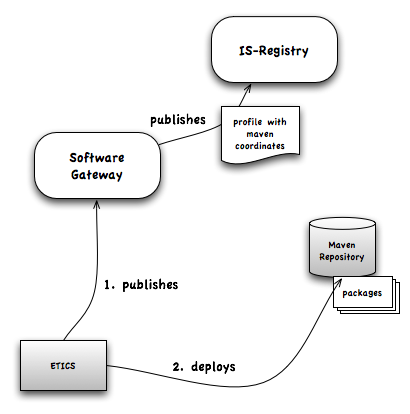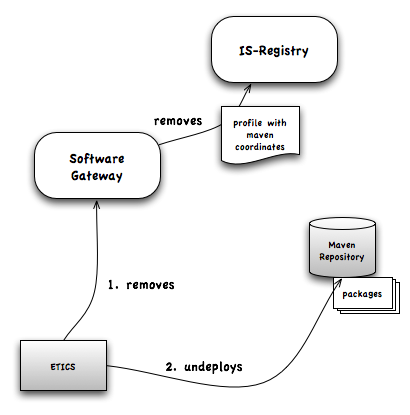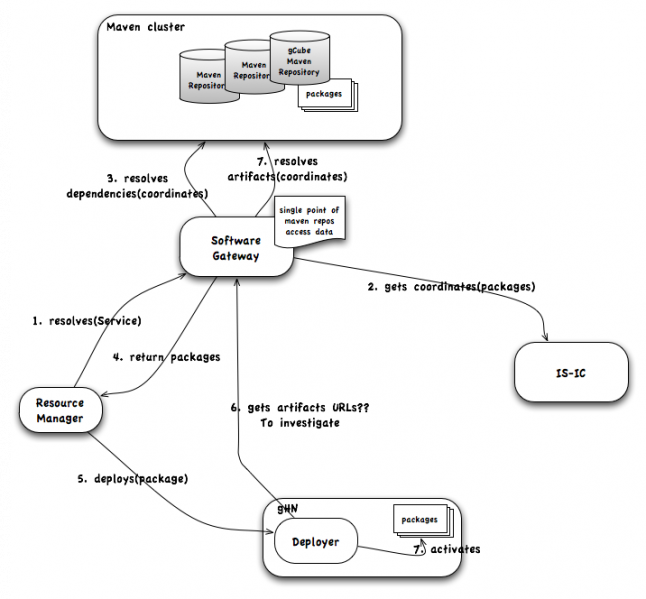Software Gateway
Role
Primary Roles:
- the new service is a gateway over N Maven Repositories for the enabling layer
- the new service will certifies which software is deployable withing the infrastructure
More specifically:
- it represents a single point of configuration of a cluster of Maven Repositories in the whole infrastructure (hence, will avoid to configure each gHN for accessing to the recognized Maven repositories)
- enabling services aiming at communicating with the registered Maven Repositories must talk with the Software Gateway
- external services may communicate directly with the Maven Repositories
- it minimizes the impact of the new physical storage (Maven) on the other enabling layer services
- it serves as mediator from the gCube coordinates (service name, class, version, package name, package version) to the Maven coordinates (groudID,artifactID,version)
- the service is responsible for publishing service profiles in the Information System
- the service does not deal with the packages storage
- the service is scope-agnostic (all the software available in the maven repository must be visible to all the clients)
What it is not be:
- a gateway over N Maven Repositories for the rest of the world (only for the enabling layer)
- a wrapper around the Maven API
Packaging Model
As a result of the gCube mavenization, gCube adopted the following packaging model:
About gCube components, a build of component generates 2 artifacts:
- the main artifact (JAR/WAR/GAR);
- a second artifact for deployment and distribution purposes (Software Archive) with the descriptors of the artifact (README, LICENSE, INSTALL, MAINTAINERS), the pom.xml, profile.xml and all the other files belonging the package (such as installation script, reboot scripts and so on), including the main artifact. It will be a tar.gz archive.
2) may contain more than one artifact, depending on the nature of the gCube component (Maven-based or Ant-based).
About external components:
- usually there is 1 artifact (the main one) per component (hosted in a non-gCube Maven repository)
- optionally, there exists a Software Archive artifact per component (hosted in a gCube Maven repository) in case that custom deployment actions or special needs are needed.
How SG deals with them? Regarding the main artifacts, the SG "simply" interfaces the configured Maven repositories to look for them and deals only with their main binary artifact.
Regarding the SA artifacts, the SG needs to do some extra-management actions when they are multi-packages.
Scenarios
gCube Software Registration
Removal
Support to Deployment
Service Interface
Registration portType:
-
String register(profile): accepts a service profile with a list of packages inside, return the ID assigned. The profile must include the Maven coordinates for each package -
void unregister(ServiceName, ServiceClass, ServiceVersion, PackageName, PackageVersion)
Access portType:
-
URL getLocation(ServiceName, ServiceClass, ServiceVersion, PackageName, PackageVersion): returns the HTTP location from which the package can be downloaded -
URL getSALocation(ServiceName, ServiceClass, ServiceVersion, PackageName, PackageVersion): returns the HTTP location of the Service Archive connected to the package, if any. If a SA is returned, the Deployer executes the instructions inside as pre/post deployment and undeployment operations -
List<package> getDependencies(ServiceName, ServiceClass, ServiceVersion, PackageName, PackageVersion): returns an XML document reporting the actual resolved dependencies and the missed dependencies (unresolved). PackageName and PackageVersion are optional parameters: if they are not set, the operation must look for the package declared as "service" and for the last version -
List<package> getPackages(ServiceName, ServiceClass, ServiceVersion): return the gCube packages belonging that service. -
List<package> getPlugins(ServiceName, ServiceClass, ServiceVersion, PackageName, PackageVersion): returns the list of plugins targeting the package or an empty list
All the above operations throw a ServiceNotAvailableFault if the requested package is not available in any repository.
Implementation
Conversions
Software Gateway deals with two types of coordinates: gCube coordinates and Maven coordinates.
GCube coordinates are expressed as quintuples: <ServiceClass, ServiceName, ServiceVersion, PackageName, PackageVersion>.
Maven coordinates are expressed as triples: <groupId, artifactId, version>.
The Software Gateway often needs to convert gCube coordinates in Maven coordinates and vice versa. In such cases, the following conversions are applied:
- Conversion gCubeToMaven
- groupId = service class
- artifactid = package name
- version = package version
- Conversion MavenTogCube
- service class = groupId
- service name = artifactId
- service version = 1.0.0
- package name = artifactId
- package version = version
Registration PortType
Registering a New Software
The service receives in input a service profile and registers it in all the scopes it is configured to run. The service returns a report including information about the newly registered gCube packages.
Here is an example of such a report:
<Packages> <Package> <groupID>org.gcube.common</groupID> <artifactID>rapidminer-custom</artifactID> <version>1.0.0</version> <ID>d3217750-9b6a-11e1-be35-f7d8862056ea</ID> <URL>http://maven.research-infrastructures.eu/nexus/service/local/artifact/maven/redirect?r=gcube-staging&g=org.gcube.common&a=rapidminer-custom&v=1.0.0&e=jar</URL> <javadoc>http://maven.research-infrastructures.eu/nexus/service/local/artifact/maven/redirect?r=gcube-staging&g=org.gcube.common&a=rapidminer-custom&v=1.0.0&c=javadoc</javadoc> <Status>SUCCESS</Status> <Operation>NEW</Operation> <Timestamp>1336741892744</Timestamp> </Package> </Packages>
Unregistering a Software
The service receives in input the gCube coordinates that identify a package. Then, it performs the following steps:
- query the IS in order to harvest the profile matching such gCube coordinates
- if the profile reports only that package, the whole profile is deleted from the IS (all scopes)
- if the profile reports other packages, the package is withdrawn from the list of packages and the modified profile is updated in the IS (all scopes)
Access PortType
Getting a Software Location
The service receives in input the gCube coordinates that identify a package. Then, it performs the following steps:
- query the IS in order to harvest the profile matching such gCube coordinates
- if a profile is returned, then extract the Maven coordinates from the profile
- if not, the conversion gCubeToMaven is applied
- having the Maven coordinates, query the configured Maven repositories until a main artifact with such coordinates is found
- find the URL of the artifact (with the REST interface exposed by Maven)
- return the URL from which the package can be downloaded
Getting Dependencies
The service receives in input the gCube coordinates that identify a package. Then, it performs the following steps:
- query the IS in order to harvest the profile matching such gCube coordinates
- if a profile is returned, then extract the Maven coordinates from the profile
- if not, the conversion gCubeToMaven is applied
- having the Maven coordinates, query the configured Maven repositories and prepare the following 2 lists:
- resolved dependencies
- missing dependencies
- elements in the list are expressed in Maven coordinates that must be converted in gCube coordinates
- for each element in the lists, query the IS in order to find the service profile with such Maven coordinates
- if a profile is returned, the gCube package's coordinates are extracted from the profile
- if not, the conversion MavenTogCube is applied
- finally, prepare the XML report to return to the caller
Here's an example of the report returned:
<DependencyResolutionReport> <ResolvedDependencies> <Dependency> <Service> <Class>Portal</Class> <Name>ThumbnailService</Name> <Version>1.00.00</Version> </Service> <Package>Thumbnailer-service</Package> <Version>1.00.00</Version> <Scope level="GHN"/> </Dependency> <Dependency> <Service> <Class>Portal</Class> <Name>ThumbnailService</Name> <Version>1.00.00</Version> </Service> <Package>Thumbnailer-stubs</Package> <Version>1.00.00</Version> <Scope level="GHN"/> </Dependency> </ResolvedDependencies> <MissingDependencies> <MissingDependency> <Service> <Class>ExternalSoftware</Class> <Name>imageJ</Name> <Version>1.40.00</Version> </Service> <Package>imageJ</Package> <Version>1.40.00</Version> <Scope level="GHN"/> </MissingDependency> </MissingDependencies> </DependencyResolutionReport>
Getting a Software Archive
The service receives in input the gCube coordinates that identify a package. Then, it performs the following steps:
- query the IS in order to harvest the profile matching such gCube coordinates
- if a profile is returned, then extract the Maven coordinates from the profile
- if not, the conversion gCubeToMaven is applied
- having the Maven coordinates, query the configured Maven repositories to find the secondary artifact (we will see later on how it is characterized) related to the package
- find the URL of the artifact (with the REST interface exposed by Maven)
- download locally the tarball and uncompress it
- if it contains more than one package, create a local SA archive with only the package requested
- re-tar the SA and put in a local (cachable folder)
- return the URL from which the local SA can be downloaded
SGClient
A client library that implements a high-level facade to the remote APIs of the Software Gateway service
Interface
The methods invoked the correspondent method on SoftwareGateway service. Every method accepts a set of standard parameters that are: scope and epr . Furthermore, the methods accepts the parameter specified below:
-
DepSolverClient, accepts a set of gcube package coordinates and return an XML that contains the dependencies resolved and missed -
GetLocationClient, accepts a set of gcube package coordinates and returns the url of the package associated -
GetPackagesClient, accepts a set of gcube service coordinates and returns a list o package coordinates -
GetPluginsClient, accepts a set of gcube service coordinates and returns a list of plugin's coordinated that match with the service -
GetSALocationClient, returning the ServiceArchive location for a inptu set of gcube package coordinates -
RegisterProfileClient, accepts a profile and register it on the information system service -
RemoveProfileClient, unregister a profile from information system service, identifies by the input coordinates
Sample Usage
The following example show a call from console to method RegisterProfileClient, for register a profile present in the file profilexm.xml
java -classpath softwaregateway-stubs-1.0.0-SNAPSHOT.jar:SGClient.jar RegisterProfileClient http://node4.d.d4science.research-infrastructures.eu:8080/wsrf/services/gcube/vremanagement/softwaregateway/Registration /gcube/devsec /home/xxx/Documenti/SoftwareGatewayDocs/yyy/profilevm.xml


